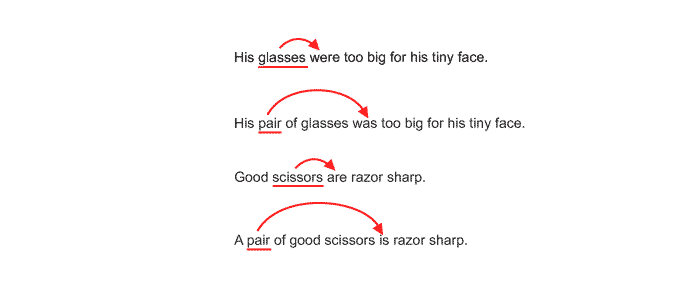Introduction

Unlike the boy in the cartoon, you don’t want your subjects and verbs to disagree. Most of the time, subject-verb agreement isn’t a problem because you recognize there’s something wrong with sentences such as “They says hello” or “Mary jumps high.” Besides sounding awful, they’re grammatically incorrect because “They” is plural in number, while “says” is singular; “Mary” is singular in number, but “jump” is plural. The subjects and verbs obviously don’t agree. Sometimes, however, when you’re editing more complex sentences, determining whether a subject and a verb match might be more difficult. For example, the verb may be evident, but which one of several nouns and pronouns in the sentence is the subject of the verb? And are the subject and the verb both singular or both plural?
You want your writing to be as error-free as possible, but figuring out subject-verb agreement quandaries can be confusing. That’s why this lesson will come in handy. We’re going to provide some tips about how to locate and correct agreement problems; then you will have a chance to practice your skills and feel more confident about writing sentences with subjects and verbs that agree.
Here’s the simple principle you need to remember as you edit for subject-verb agreement:
A subject and a verb must agree in number, which means a singular subject needs a singular verb, and a plural subject needs a plural verb.
With that in mind, let’s get started.
Quick Subject-Verb Review
Before you can edit for agreement, identify the subject and verb that must agree in the sentence. How do you do that? Usually if you can find the verb—the action or state of being word—you can find the subject. Ask yourself, “Who or what (fill in the blank with the verb)?” The answer is the subject of the verb. Look at these examples:
- Before school every day, Ray eats fourteen pancakes. verb = eats; who or what eats? Ray= subject
- Those two girls are the funniest people in the world. verb = are; who or what are? girls = subject
Note: This approach suggests that a sentence can contain only one verb, when in reality we know that a sentence can have more than one clause, and each clause has at least one subject and one verb.
Now that you have found the subject, look at it carefully. What is its number? In other words, is the subject singular or plural? This is important because the number of the subject determines the number of the verb. If a singular subject has a plural verb, you will have to change the verb to make it singular so it agrees with the subject; if a plural subject has a singular verb, the verb must be changed so that it’s plural too.
If you remember the following trick, determining whether verbs are singular or plural will be much easier: while most nouns form their plurals by adding –s or –es, that’s not the case with verbs. The quickest way to figure out whether a verb is singular or plural is to put a singular or plural personal pronoun with it. If the pronoun he or she agrees with the verb, the verb is singular; if the plural pronoun they works with the verb, the verb is also plural. For example, he smile? No, he smiles. The verb smiles is singular. They laughs? No, they laugh. The verb laugh is plural.
 The quickest way to figure out whether a verb is singular or plural is to put a singular or plural personal pronoun with it.
The quickest way to figure out whether a verb is singular or plural is to put a singular or plural personal pronoun with it.
When Conjunctions Connect Subjects
 Photo by Adrienne Breaux
Photo by Adrienne BreauxEnsuring that verbs agree in number with their single noun subjects is one thing, but how do you edit for subject-verb agreement when sentences have two or more subjects connected by conjunctions? Two rules will help to answer this question.
Rule #1: Use a plural verb with two or more subjects connected by the conjunction and.

This principle applies only to the use of and, not to the use of phrases such as together with, as well as, or along with because they are not conjunctions.

Exception to the and rule: Use a singular verb when the nouns connected by and are so closely associated with each other that they are considered to be describing one thing.

Rule #2: Use a singular verb when singular subjects are connected by the conjunctions or or nor.

When connecting a singular subject and a plural subject with the conjunctions or or nor, be sure the verb agrees in number with the subject that is closer to the verb. Proximity to the verb counts, whether the subject is before the verb or not.

To avoid awkward-sounding sentences like Either my speakers or my printer is broken, some grammar experts suggest that when joining a singular subject and a plural subject with or or nor, put the plural subject closer to the verb, thus requiring a plural verb. That’s just a suggestion, however, and is not mandatory.
In the sentences that follow, practice recognizing subject-verb agreement by choosing “Yes” if they agree in number and “No” if they don’t agree.
When Subjects are Indefinite Pronouns
Personal pronouns can serve as subjects. It’s fairly simple to figure out which ones are singular and which are plural: I, he, she, and it are singular and agree with singular verbs; we and they are plural and need plural verbs. You can be singular or plural, depending on whether it refers to one person or more than one. However, when indefinite pronouns are the subjects of sentences, subject-verb agreement problems can arise. It’s not as easy to determine whether these types of pronouns are singular or plural.
- MOST indefinite pronouns agree with singular verbs, even though every- and some- would seem to indicate more than one. Think about this, though: one, body, and thing are all singular, right? That’s the clue as to why the pronouns in the first three rows of the table below are singular. You’ll need to commit the bottom row to memory.
| One words | One | Anyone | Everyone | Someone | No one |
| Body words | Anybody | Everybody | Somebody | Nobody | |
| Anything | Everything | Something | Nothing | ||
| Each | Either | Neither |

Stop for a moment and notice that the previous sentence illustrates an important point to remember: Sometimes many words, phrases, and/or clauses separate the main subject and its verb, but no matter how long the sentence is, the subject and verb must agree.
Don’t get frustrated and become lost in the words; instead, remind yourself of the process we’ve already discussed. Systematically find the verb and ask yourself, “Who or what (put the verb in the blank)?” The answer, as you know, is the subject, and all you have to do then is to determine its number and be certain the verb agrees with that number.
- A few indefinite pronouns—including
both ,few ,many , andseveral —are plural and need a plural verb. - Six indefinite pronouns (
all ,any ,more ,most ,none ,some ) can be singular or plural subjects, depending on whether the word they refer to is singular or plural.


Check your understanding of this section by taking this short quiz. Read each sentence carefully to determine its verb and subject(s). Before you select an answer, you must first correctly identify and click on the verb and subject(s). If the subject and verb agree, check YES; if they don’t, check NO.
Special Cases
Although the two previous sections dealt with the kinds of sentences where most subject-verb agreement errors occur, there are several other occasional problems that you need to be aware of to properly edit your writing. This section is divided into examples of when to use singular verbs for agreement, when to use plural verbs for agreement, and when—depending on the meaning of the sentence—to use verbs of either number.
To have subject-verb agreement, use SINGULAR verbs . . .
- with nouns that appear plural because they end in "s" but which are clearly referring to one thing.
- with titles.
- with sums of money or periods of time.



To have subject-verb agreement, use PLURAL verbs with . . .
- nouns such as pants, glasses, trousers, scissors, and pliers, unless they are preceded by the phrase
pair of . In that case, pair is the subject and, strangely enough, is a singular noun that calls for a singular verb.

In order to have subject-verb agreement—and depending on the meaning and structure of the sentence—use either singular OR plural verbs with . . .
- collective nouns. In most sentences, a collective noun refers to a group as a single unit, so it needs a singular verb. Ask yourself if the group is doing something together as a whole.
- Occasionally, however, a collective noun refers to the group as individual members, so it needs a plural verb. Ask yourself if the unit members are acting individually.
- words that indicate portions or fractional parts (i.e.,
two-thirds ,percent ,half of , part ,majority ,remainder ). The number of the verb depends on the meaning of the sentence. - inverted sentences. When a sentence is flip-flopped, and the verb comes before the subject rather than following it, finding the subject and verb and making sure they agree can be challenging. Inversion usually occurs in one of three situations.



- Questions have the subject after the verb.
- Hint: It’s easier to find the subject and verb if you make the question into a declarative statement, such as
"The response was positive or negative " or"The three doors are open ." - Sentences that start with
here orthere have the subject after the verb.Here andthere are not nouns or pronouns, so they will never be subjects; therefore, in a sentence beginning with one of those words, the actual subject is after the verb. - Sometimes writers invert sentences to get a reader’s attention or to emphasize a word, phrase, or idea. Again, it is easier to locate the subject and verb if you rearrange the sentence so the subject comes before the verb.



Before you test yourself on how well you understood this entire lesson, you might want to go to this interactive site and do some extra practice.
Test Your Understanding
The following short, two-part test will give you a good idea of how well you understood the lesson on subject-verb agreement. Click on the verb that agrees with the subject(s) in each sentence.
For the last part of the test, select the appropriate verbs from the drop-down menus to complete each sentence correctly.
Resources
Resources Used in this Lesson: Bibliography
Simmons, Robin L. “Subject-Verb Agreement.” Grammar Bytes!. http://www.chompchomp.com/
exercises.htm#subject-verb_agreement.